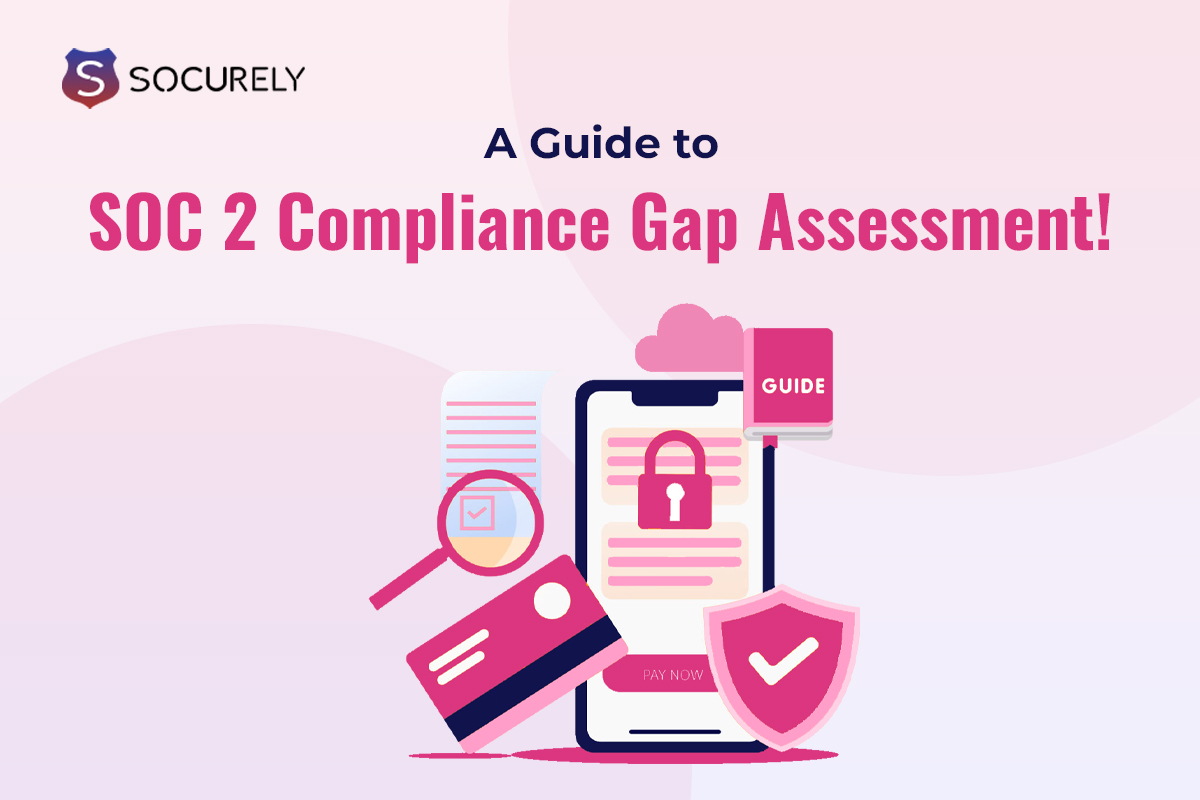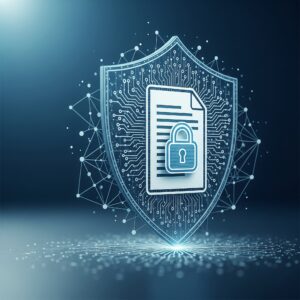Want to secure your business and customers’ sensitive data from the growing, modern cyber threats? There is a SOC 2 compliance solution to all your security threats.
SOC 2 compliance is crucial for service organizations, especially those in the SaaS, cloud computing, and IT services sectors. It demonstrates your commitment to maintaining the highest standards of security, availability, processing integrity, confidentiality, and privacy.
But what about the Compliance gaps?
The journey towards compliance can be fraught with challenges, including identifying and closing compliance gaps! This blog provides a comprehensive guide on how to effectively assess and address SOC 2 compliance gaps, ensuring your organization not only meets but exceeds the required standards.
Infographic-
According to a study by the Ponemon Institute, data breaches cost companies an average of $3.86 million, underscoring the need for robust compliance frameworks.
Stand against cyber threats and protect your business with Socurely SOC 2 Compliance Framework and Support!
Get Your SOC 2 Assessment with us today!
The Growing Demand for SOC 2 Compliance
With increasing regulatory scrutiny and customer expectations, the demand for SOC 2 compliance is rising. A report by Markets and Markets predicts that the global compliance and risk management solutions market will grow from $27.3 billion in 2021 to $56.0 billion by 2026. This growth highlights the critical need for organizations to implement effective compliance measures.
What is SOC 2?
SOC 2, or System and Organization Controls 2, is a criterion developed by the American Institute of Certified Public Accountants (AICPA). It is designed to ensure that service organizations manage customer data securely. To comply with SOC 2 standards, a company must meet five criteria, which include- Security, Availability, Processing Integrity, Confidentiality, and Privacy.
The Trust Service Criteria
- Security: It is mandatory and ensures protection against unauthorized access (both physical and logical).
- Availability: Ensuring systems are available for operation and use as committed.
- Processing Integrity: It guarantees that the performed system processing is finished, valid, accurate, timely, and authorized.
- Confidentiality: It protects any confidential information as committed or agreed.
- Privacy: Ensuring personal information is collected, used, retained, disclosed, and disposed of by the entity’s privacy notice.
Steps To Identify SOC 2 Compliance Gaps-
Conducting a Gap Analysis
The first step in identifying SOC 2 compliance gaps is to conduct a comprehensive gap analysis. This involves comparing your current practices against the SOC 2 requirements to identify improvement areas.
Steps to Conduct a Gap Analysis
- Internal Audits: Regularly conduct internal audits to assess your current compliance status. This helps identify deviations from SOC 2 standards.
- Consult External Experts: Bringing in external SOC 2 compliance experts can provide an unbiased assessment of your compliance status.
- Review Existing Controls: Evaluate your existing security measures, availability protocols, processing integrity checks, confidentiality safeguards, and privacy practices against the SOC 2 criteria.
Reviewing Policies and Procedures
Your organization’s policies and procedures are critical components of SOC 2 compliance. Review these documents to ensure they align with the Trust Service Criteria.
- Security Policies: Ensure you have comprehensive security policies that address access controls, encryption, and network security.
- Availability Policies: Verify that your availability policies include disaster recovery and business continuity plans.
- Confidentiality Policies: Review your confidentiality policies to ensure they adequately protect sensitive information.
- Privacy Policies: Ensure your privacy policies comply with data protection regulations and your privacy commitments.
Steps To Close SOC 2 Compliance Gaps
Implementing Corrective Actions
Once you have identified compliance gaps, the next step is to implement corrective actions. This involves developing and executing a plan to address each gap.
Steps to Implement Corrective Actions
- Develop an Action Plan: Create a detailed action plan outlining the steps needed to close each compliance gap. Ensure timely completion by assigning responsibilities and setting deadlines.
- Monitor Progress: Make sure your action plan is progressing as expected. Make sure your action plan is progressing as expected. Conduct follow-up audits to ensure corrective actions have been effectively implemented.
Enhancing Security Controls
Strengthening your security controls is a critical aspect of closing SOC 2 compliance gaps. This includes updating access controls, improving encryption methods, and enhancing network security.
- Access Controls: Take steps to prevent unauthorized access by implementing strong authentication mechanisms.
- Encryption: Use advanced encryption techniques to protect data both at rest and in transit.
- Network Security: Ensure that firewalls, intrusion detection systems, and other network security measures are in place and properly configured.
Improving Risk Management
Effective risk management is essential for maintaining SOC 2 compliance. This involves identifying, assessing, and mitigating risks to your information systems.
- Risk Assessment: Conduct regular risk assessments to identify potential threats to your systems and data.
- Risk Mitigation: Implement risk mitigation strategies, such as security controls and contingency plans, to reduce the impact of identified risks.
Practical Example of Mapping SOC 2 Criteria to ISO 27001
Consider a company that handles customer data and needs to ensure it meets both SOC 2 and ISO 27001 compliance. Here’s a practical mapping example:
Access Control
SOC 2 Security Principle: Ensure systems are protected against unauthorized access.
ISO 27001 Annex A.9: Implement access control policies, user authentication, and authorization mechanisms.
Risk Management
SOC 2 Continuous Risk Evaluation: Identify and mitigate risks to the system.
ISO 27001 Clause 6: Develop a risk management framework that includes risk assessment and treatment.
Change Management
SOC 2: Ensure changes to the system are authorized, tested, and documented.
ISO 27001 Annex A.12: Implement a formal change management process.
Vendor Management
SOC 2: Ensure third-party vendors comply with security requirements.
ISO 27001 Annex A.15: Establish policies and procedures for managing vendor relationships.
Incident Response
SOC 2: Develop an incident response plan to handle security breaches.
ISO 27001 Annex A.16: Implement an incident management process.
Backup and Data Recovery
SOC 2: Ensure data is backed up and can be restored in case of loss.
ISO 27001 Annex A.12: Develop and test backup and data recovery procedures.
Benefits of SOC 2 Compliance Gap Assessment
Enhanced Security
Conducting a SOC 2 compliance gap assessment helps identify vulnerabilities in your security measures. By addressing these gaps, you can enhance your organization’s overall security posture.
Increased Trust and Credibility
Achieving SOC 2 compliance builds trust with your clients and stakeholders. It demonstrates your commitment to protecting customer data and enhancing your organization’s credibility and reputation.
Streamlined Compliance Efforts
Identifying and addressing SOC 2 compliance gaps can streamline your overall compliance efforts. This reduces redundancy and ensures that your organization meets all necessary standards efficiently.
Socurely’s Support In SOC 2 Gap Assessment
Being the leading compliance agency, we at Socurely pride ourselves on our comprehensive approach to SOC 2 gap assessment. Our team of experts employs a multi-faceted strategy to ensure your organization meets all SOC 2 requirements efficiently and effectively. Here are the key components of our support:
- Running SOC 2 Compliance Scans: We utilize advanced compliance scanning tools to automatically assess your current security measures against SOC 2 criteria. These scans identify potential vulnerabilities and gaps, providing a detailed report that outlines areas needing improvement.
- Performing a Manual Compliance Gap Analysis: In addition to automated scans, our specialists conduct a thorough manual review of your existing policies, procedures, and controls. This hands-on approach ensures no stone is left unturned, allowing us to pinpoint even the most nuanced compliance gaps.
- Customized Compliance Solutions: We understand that each organization has unique needs. Our team works closely with you to develop tailored compliance strategies that align with your specific business objectives and operational requirements.
- Continuous Monitoring and Support: Compliance is an ongoing process. Socurely offers continuous monitoring services to ensure that your organization remains compliant with SOC 2 standards over time. Our support extends beyond the initial assessment, providing regular updates and guidance to adapt to evolving compliance landscapes.
- Expert Guidance and Training: We equip your team with the knowledge and tools necessary to maintain compliance. Through targeted training sessions and expert consultations, we empower your staff to uphold SOC 2 standards in their daily operations.
By leveraging our expertise and comprehensive services, Socurely ensures your path to SOC 2 compliance is clear, efficient, and sustainable. With our support, you can confidently address any compliance gaps and focus on driving your business forward.
FAQ-
- What are the criteria of SOC 2?
SOC 2 criteria, also known as Trust Service Criteria, include Security, Availability, Processing Integrity, Confidentiality, and Privacy. These criteria ensure that systems are protected against unauthorized access, are available for operation, process data accurately, protect confidential information, and handle personal data by privacy commitments.
2. Why is mapping SOC 2 compliance with ISO 27001 important?
Mapping SOC 2 compliance with ISO 27001 is important because it helps organizations streamline their compliance efforts. By identifying common criteria and aligning their controls, organizations can efficiently manage compliance with both standards, reducing duplication of efforts and ensuring a robust security posture.
3. Does SOC 2 and ISO 27001 complement each other?
SOC 2 and ISO 27001 complement each other by providing comprehensive guidelines for managing information security. While ISO 27001 focuses on establishing a robust ISMS, SOC 2 emphasizes protecting customer data through specific criteria. Together, they offer a holistic approach to information security and compliance.
Conclusion
Achieving and maintaining SOC 2 compliance is critical for protecting customer data and building trust with clients. By conducting a thorough gap analysis and implementing corrective actions, you can identify and close SOC 2 compliance gaps effectively. With expert guidance from Socurely, your organization can achieve compliance and turn it into a strategic advantage.







